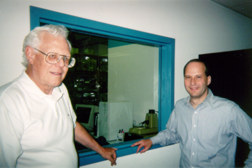| In the News | Augutst 27, 2001 |
|
Electronic Engineering Times Daughton has been developing magnetic technologies ever since, moving to NVE when it spun off from Honeywell in 1989. What attracted him, and several major corporations, is the fact that magnetic memories are non-volatile and they are faster than RAM. MRAMs also offer the density of common RAM with about the same number of process steps. So costs in equal volumes should be similar, and costs for initial adopters should be low enough to convince many designers to end their long love affair with RAM. "Many people consider this as revolutionary as when high-density semiconductor memory came out 25 or so years ago," said Dan Baker, president and chief executive officer at NVE. "We feel this can really change things, providing instant-on computing, since there’s no need to transfer data from the hard drive to RAM. A whole range of embedded products will run better. Imagine if a PDA did not require a hard drive, think of the size and power differences a user could see." However, the benefits don’t come easily. There are several production hurdles yet to be overcome, and once products are out, system designers will have to make some changes to take advantage of the new technology. But companies like Honeywell and Motorola, which licensed NVE’s technology a few years ago, are pressing forward. "We are driving the technology with anticipation of production in 2004 and samples in 2003," said Saied Tehrani, MRAM technology manager at Motorola Semiconductor Products Sector (Tempe, Ariz.). Following company policy, he would not comment on the NVE agreement, but did say that Motorola’s MRAM technology "has evolved significantly" since NVE and Motorola linked up in 1995. NVE’s technology itself has evolved a fair amount since then. While enhancing memories, NVE has leveraged the magnetic technology to make isolators that are 10 times faster than traditional parts. "The isolators allow speeds people aren’t able to achieve in broadband, and they can help extend the range of DSL to 10 miles instead of a couple of miles," said Baker, who joined the company at the start of the year to commercialize the isolators and a magnetic sensor technology that’s in the final stages of development. Though isolator sales are growing quickly, MRAMs are still the focus of the company. Daughton and his staff have some ideas on increasing the density of MRAMs, and some patents are expected to gain approval soon. "I expect that before the year is out, I’ll be out selling licenses for that." Licensing has been the key revenue source for the public company. Of the $7.2 million NVE had in sales last year, only $750,000 came from product sales, Baker said. "The balance came from R&D, primarily government R&D, along with licensing." The military was a big driver of MRAM technology back in the 1980s. The Pentagon was intrigued with its rad-hard capabilities, as well as the benefits that pulled in commercial entities. Indeed, NVE existed on government R&D contracts until 1995, when Motorola took the first license. Daughton credits much of the success of MRAMs to Art Pohm, who was a consultant to Honeywell when the concepts came into being. Pohm had been Daughton’s main professor at Iowa State University, and the retired professor is still a consultant to NVE. The two men, along with the other PhDs who make up NVE’s engineering department, have a long history with magnetic technology. Improvements in lithography helped push the technology forward, but perhaps even more important was the discovery of the magnetoresistive effect in 1988. While MR technology is known mainly because MR heads permit the huge capacities of today’s disk drives, MR also boosted the sensitivity of MRAMs and sensors, bringing them closer to commercial viability. Now, one of NVE’s biggest concerns is whether MRAMs will ever have the kind of success that will justify the founders’ years of labor. Some observers have said that the high volumes of MRAMs, along with the comfort level of designers who implement them, will make it difficult for MRAMs to enter the market. Daughton noted that MRAM "works virtually identical to what SRAM is like. But in terms of taking full advantage of the instant-on aspect of MRAM, it might take a while. People are familiar with refresh, though it’s not a big deal to eliminate it. Taking full advantage of not using refresh will take some time." But with Motorola, IBM, Infineon, and others pushing the technology, he’s optimistic that system engineers will start with low-volume products, then migrate the technology into higher-volume systems. "I expect that before long we’ll see it in applications that need nonvolatility and speed," Daughton said. "It’s got at least a fighting chance to make it as a mainstream product." That said, Daughton does realize that there’s a long row to hoe for MRAMs. That means there’s a chance that NVE engineers and others may have to settle for MRAMs becoming a niche product. Or worse. "Engineers always fear that," Daughton said. "But I do think the fundamentals are there. A lot of companies are working on it. Micron and HP are looking at MRAMs." |
